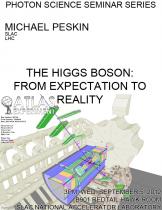Michael Peskin (SLAC, LHC)
Since the beginning of July, your colleagues in the PPA Division seem unable to utter a sentence that does not include the words "Higgs Boson". The Higgs Boson is often described as the particle necessary to generate mass for all other elementary particles. But, why should such a particle be necessary? Why is the Higgs so important? Why was it so hard to find? What is the evidence that it actually was found? In this lecture, I will answer these questions and address the present and future of the Higgs Boson's story.
The image is an event from the ATLAS experiment that is a candidate for the process pp -> Higgs -> Z Z , with one Z decaying to e+e- and the other to mu+mu-. The mass of the 4-lepton system is 124.3 GeV.





